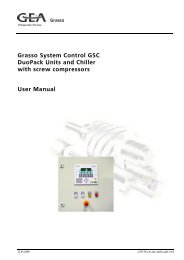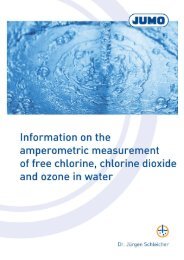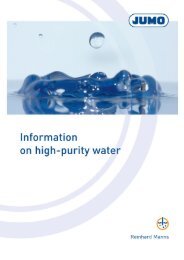FAS622en_pH measurement
Create successful ePaper yourself
Turn your PDF publications into a flip-book with our unique Google optimized e-Paper software.
5 Other methods for <strong>pH</strong> <strong>measurement</strong><br />
ISFET<br />
ISFET stands for ion selective field effect transistor. These sensors differ not so much as a result of<br />
the membrane material but rather because of their construction.<br />
For the high-impedance <strong>pH</strong> <strong>measurement</strong> with glass electrodes, a high-performance instrumentation<br />
amplifier (transistor) is required. Normal instruments have a resistance of at least 10 12 . One<br />
of the reasons for this is the high resistance of the glass membrane. The amplifier is often mounted<br />
in the instrument, in the fitting, or in a separate unit installed between the electrode and the instrument.<br />
The greater the distance between membrane and amplifier, the more sluggish and unresponsive<br />
is the signal transmission. With a long transmission path, each change in <strong>pH</strong> value means a<br />
time-consuming generation and movement of electric charges.<br />
Fig. 21:<br />
ISFET sensor<br />
(1) Reference electrode (5) p-Si substrate<br />
(2) Measured medium (6) n-Si source<br />
(3) Gate region with H + ion-sensitive coating (e. g. Ta 2 O 5 ) (7) Insulation<br />
(4) n-Si drain<br />
With an ISFET sensor, the membrane forms a single unit with the amplifier. One advantage of this<br />
arrangement is the good response and reduced susceptibility to interference. As miniaturization of<br />
transistors does not present a problem, ISFET sensors are an interesting alternative in the field of<br />
biological and medical applications.<br />
Depending on the membrane material, ISFET sensors have a limited range, worse linearity, shorter<br />
service live, reduced reliability, and are sensitive to light in some cases. These are without doubt<br />
some of the reasons why, until now, ISFET sensors have been used predominantly for operational<br />
<strong>measurement</strong>s with hand-held instruments and for laboratory <strong>measurement</strong>s in biology and medicine.<br />
Finally, a reference electrode is also needed for <strong>pH</strong> <strong>measurement</strong> with ISFETs. This can be designed<br />
as a conventional reference system, which to some extent negates the ISFET’s major advantage.<br />
Until now, other solutions using ISFET technology, known as REFETs (reference field effect<br />
transistor), have not demonstrated an adequate long-term stability.<br />
44 5 Other methods for <strong>pH</strong> <strong>measurement</strong> JUMO, FAS 622, Edition 04.07














